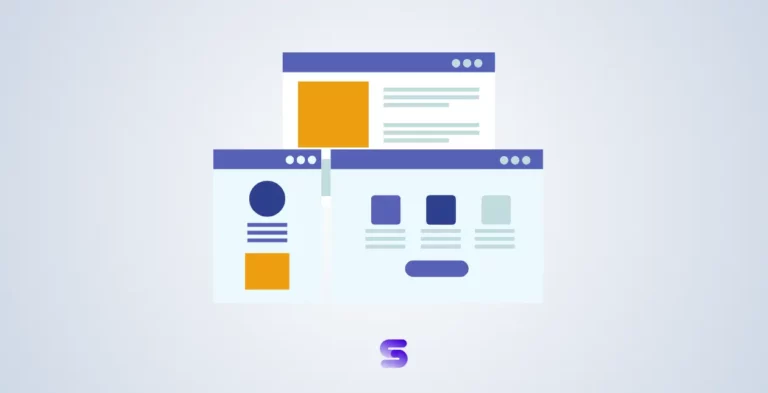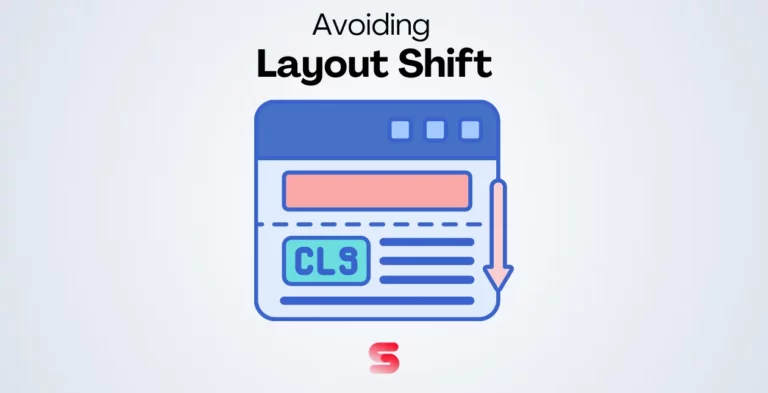Are you uncertain about the appropriate usage of H1-H6 Heading Tags in WordPress website, or How to Use Heading Tags? The strategic use of headings within your posts and pages can greatly enhance the readability of your content, elevate user experience, and improve your website’s search engine optimization (SEO) ranking.
This comprehensive article aims to provide guidance on the proper usage of heading tags within WordPress, enabling you to optimize your content effectively. But wait, “what are heading tags actually” Let us elaborate on this for better Understanding.
In WordPress, heading tags refer to HTML elements that are utilized to label the titles and headings present on a webpage. By incorporating these tags into your content, you can enhance the comprehension of your content by both visitors and search engines alike. Effective utilization of heading tags within your posts and pages can lead to an improved SEO ranking, thereby elevating your content’s visibility on search engine results pages (SERPs).
The optimal usage of heading tags involves assigning a logical structure to your content by incorporating different levels of headings. Typically, H1 tags are reserved for post titles, while H2 tags are utilized for main headings and H3 tags are designated for subheadings. By utilizing this approach, you can effectively structure your content, making it more accessible and understandable for your audience.
Even you can change the shapes and sizes of the headings styles which are regulated by your theme’s stylesheet. Customizing the appearance of these tags can augment the visual appeal of your website and ensure that your headings complement your brand’s aesthetics.
At the end of this article, you developed a good understanding of how to utilize these headings to the fullest, So keep reading.
Proper Utilization of H1-H6 Heading Tags in WordPress –
- Structuring Your Content with Headings and Subheadings
- Customize the Visual Appeal of Headings to Attract Attention
- Improve Readability and User Experience with Headings
- Enhance Your SEO with Proper Keyword Usage in Headings
- Automated Generation of a Table of Contents from Headings
- Improve headings for Google Featured Snippets to Rank better
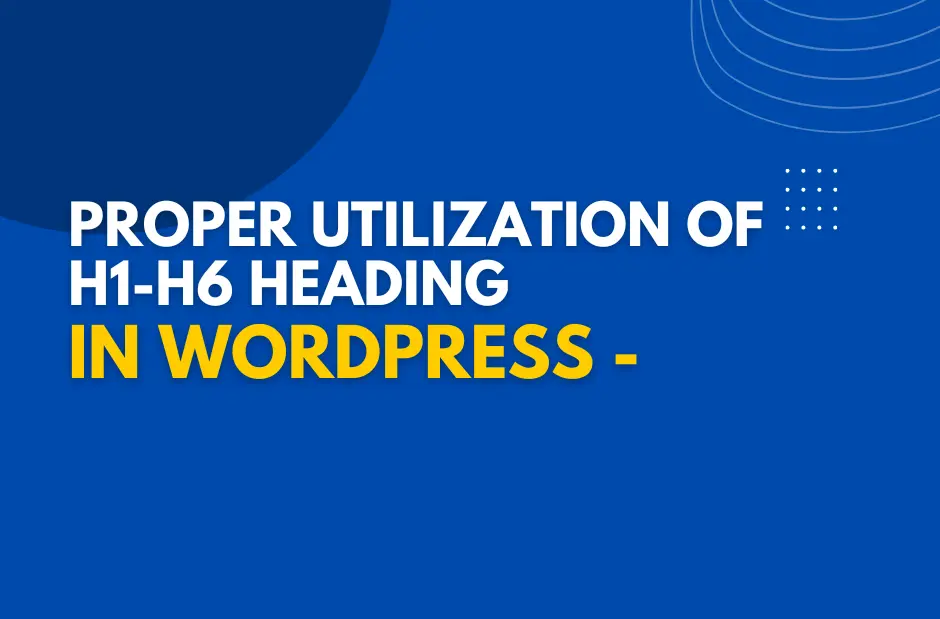
Structuring Your Content with Headings and Subheadings
Headings in your post or page help you organize your content in a Structured and logical way. It also helps your readers navigate through your article by giving them a quick overview of the main sections and how they are related to each other.
Here are some key points to keep in mind about using headings in WordPress to Structure your content effectively :
- Headings provide a logical structure for your post or page and help guide readers through the content.
- There are six hierarchical heading levels (H1-H6) available to use for structuring your content.
- H1 tags are the most important and should only be used once for the post or page title.
- H2 tags are used for main headings, while H3 tags can be used for subheadings within those sections.
- Most themes display H3 subheadings in a smaller font than H2 headings.
- In most cases, two or three levels of headings are sufficient for most posts or pages.
- Headings H4 to H6 can be used for providing further structure in longer posts or academic articles.
By structuring your posts with headings, you make it easier for both your readers and search engines to understand the context of your content. This can help your post rank higher on search engine results pages, as it shows that your content is well-organized and informative.
Customize the Visual Appeal of Headings to Attract Attention-
Including headings in your content can help grab user attention because they are usually displayed in a larger font size than the regular body text. This allows you to break your posts and pages into different sections, making it easier for readers to navigate and find the information they’re looking for.
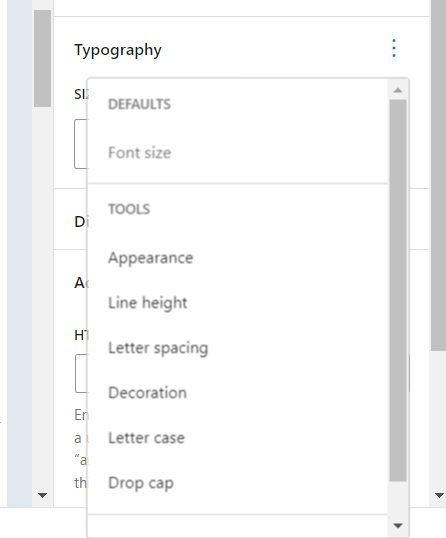
Here are some simple points on customizing the appearance of your headings:
- You can add color to your headings to make them stand out, particularly for H1, H2, and H3 headings.
- Some themes may offer preset font choices that can change the font for your entire website.
- You can also change fonts for specific elements on your theme, such as using a different font for the body text and headings.
- Some themes even allow you to use separate fonts for each heading level.
Improve Readability and User Experience with Headings-
Improving the readability of your content is crucial to retaining the attention of your audience. One effective way to achieve this is by breaking up lengthy paragraphs into shorter ones and incorporating headings. Utilizing headings not only enhances the user experience by allowing readers to easily navigate your content, but it also helps them locate specific sections they are interested in reading more thoroughly. Checking the readability of your headings is important for SEO as it can increase page views and reduce bounce rates.
One can also use All-in-One SEO as a WordPress SEO plugin that can help you optimize your website for search engines and social media platforms. The ‘Readability’ tab in AIOSEO offers suggestions on how to improve readability, such as adding images, shortening paragraphs and sentences, using transition words, and adding subheadings. (The ‘Subheading distribution’ section provides feedback on any steps you need to take to improve the headings in your post )
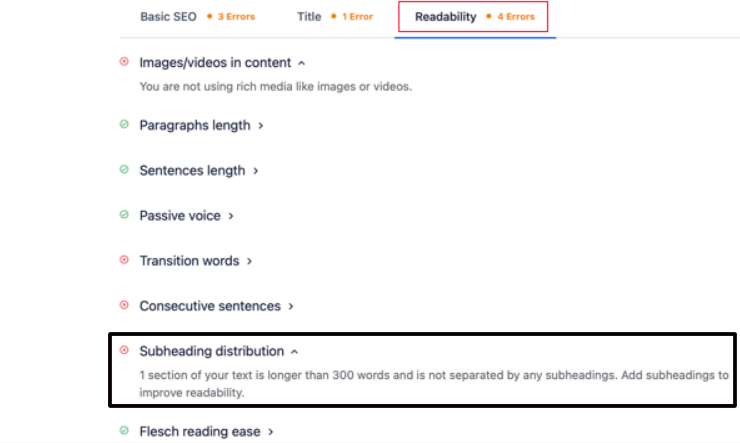
Enhance Your SEO with Proper Keyword Usage in Headings-
Headings play a crucial role in optimizing your blog posts for SEO. As search engines prioritize headings over regular paragraph text, using appropriate keywords in your headings can enhance the visibility of your content. Google relies on the content of your headings to comprehend the main topic of your blog post better. To optimize your headings for SEO, it is vital to include relevant keywords that your target audience may search for when looking for content similar to yours.
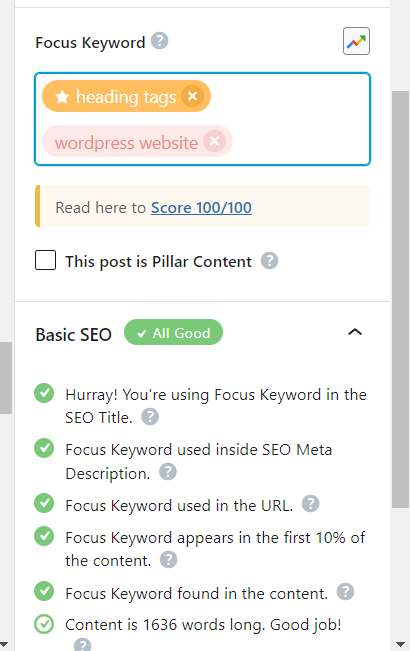
However, it is essential to avoid using irrelevant or excessive keywords in your headings, as it can lead to keyword stuffing and negatively impact your SEO. The keywords must be used judiciously and fit naturally into the content of your headings. This approach not only helps in improving the ranking of your website on search engine result pages but also enhances the overall readability of your content.
You can also use the AIOSEO plugin to optimize content accordingly with proper keywords, Here are some points to understand better.
- All-in-One SEO can help you check if you’ve used enough keywords in your headings.
- To use this feature, you just need to add a focus keyword to your post by going to AIOSEO Settings and typing it in next to “Focus Keyphrase.”
- The plugin will then analyze your content for the keyword, give you a score, and suggest ways to improve your ranking.
- All-in-One SEO can also check if your post has enough keyword-optimized H2 and H3 subheadings.
- You can use All in One SEO to optimize your post title for better SEO too.
- To get more clicks and improve your SEO, it’s important to make your headline catchy and clickable.
Automated Generation of a Table of Contents from Headings-
A table of contents is a navigational aid that provides a clickable list of headings included within a post. It enhances the user experience by facilitating easy navigation through the content, particularly for lengthy articles. By clicking on a heading in the table of contents, visitors can instantly access the corresponding section within the article. This feature expedites the process of finding relevant information, thereby improving the overall user experience.
You can use All-in-One SEO to automate this whole process and do it easily in a few septs :
- All-in-One SEO provides an automated feature that generates a table of contents by utilizing the subheadings within your post.
- The generated table of contents is fully customizable, with editable links to enhance the user experience.
- To use this feature, you need to click on the blue ‘+’ icon while editing your post and locate the ‘AIOSEO – Table of Contents’ block.

- Next, you simply drag the block to the desired location within the post or page.
- The plugin automatically identifies the headings on the page and incorporates them into the table of contents.
- If you use different heading levels (such as H2 and H3), lower-level headings will be indented to show the structure of your content.
or you can do it manually as we did :
- To create a table of contents in WordPress, first, make a list with the headings you want to include. Then, add a special code called an “anchor” to each heading so WordPress knows where to jump when someone clicks on it.
- To add an anchor, select the heading and go to the “Advanced” settings. Enter a unique word or phrase without spaces in the “HTML anchor” field. Then link the headings in the list to the anchors you created.

- To do this, highlight the heading in the list and click the “Link” icon. Type a hashtag (#) and the anchor text. Then press “Enter” or the “Submit” icon to create the link.

- Now your table of contents is ready! When someone clicks on a link in the list, they’ll be taken to the corresponding heading in your post or page.
Improve headings for Google Featured Snippets to Rank better-
Strategically arranging your heading tags can potentially enhance the visibility of your content on Google’s search engine results page, by securing a position within the coveted featured snippets section, which appears at the top of the search results page.
By effectively incorporating heading tags, Google was able to extract relevant information from the aforementioned post and showcase it in a visually distinct numbered list format, ultimately granting the post a featured snippet status.
Optimizing your content in this manner can boost your website’s traffic via improved SEO, as users tend to be more inclined to click on featured snippets than ordinary search results.


